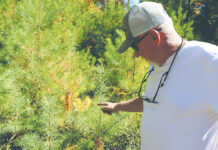The crayfish, crawdad, crawfish discussion is kind of like the creek, crick discussion — it comes down to regional preference. I’ve heard it all three ways but grew up saying crayfish.
The first time my dad took me to catch crayfish I was both nervous and enchanted by them. We rode our bikes from the home where I spent most of my childhood to the creek down the road. Under the bridge we lifted rocks to look for them, being careful not to stir the water so we could see them. And in one swift motion, dad grabbed them and lifted them up for me to inspect.
I remember asking if it hurt when they pinched his hands, but years of pouring concrete for a living had hardened them to the point the curious-looking creatures couldn’t even puncture his skin. I have been pinched and it’s uncomfortable, but not unbearable. My daughter, Vayda, has been pinched and it turned her off catching them with her hands for a long time. So we got a net.
Catching crayfish is kind of a summer tradition. The creek my dad took me to the first time now runs through his backyard and provides endless amusement. We catch tadpoles in the spring, largemouth bass and bluegill after a good rain and crayfish in the summer when the water is warmer.
Strategies to catch crayfish
Crayfish can be caught in freshwater lakes, ponds, rivers, creeks and streams. They are frequently found in habitats with slow-moving water and plenty of rocks and vegetation to provide cover.
They are easiest to find during the summer when water is warmer and most active at night because they are nocturnal. For these reasons, the best time to go crayfishing or set traps is near dusk.
Catching crayfish by hand. The best way to find crayfish is by lifting rocks in shallow areas of a creek or stream. You’ll need to be mindful of the way the water is flowing, lifting rocks into the current so the dust that gets stirred up by lifting the rock is carried out of your field of view. You also want to lift rocks slowly to avoid startling the crayfish underneath. Once you’ve located a crayfish, slowly reach your hand into the water, approaching from its tail. When you’re ready make one fluid motion to grab the crayfish’s body behind its claws to avoid getting pinched. You could also use a net to try scooping crayfish instead or to place it in front of the crayfish and attempt to get it to run in on its own by touching its tail.
Bait crayfishing. Another method you can try is by using a fishing pole and bait fishing with worms, fish parts or even a piece of hotdog or raw meat. Attach the bait to the pole by tying a fishing hook or safety pin on the end of your line and placing the bait on it. Lower the bait into the water and slowly wiggle it until you feel or see a crayfish grab hold. Then slowly pull it towards the shore. If you are close enough to see the crayfish attached to the bait, you can try scooping it up with a net.
Using traps. You can catch crayfish in larger quantities by using traps. Open traps are collapsible nets that are open at one end. Closed traps are a little more intricate with a funnel at one end to prevent crayfish from escaping. Open traps can be placed out for several hours with enough bait. Closed traps can be left overnight. Some traps are baited utilizing a hook that hangs in the center and others use bait boxes or bait jars. Traps should be no larger than three feet in height, width and depth. Cylindrical-, beehive- and cone-shaped traps are preferred to square-shaped traps.
Crayfishing regulations
Many states require a fishing license to catch crayfish in public waters. In Ohio, you need a fishing license to catch crayfish in state waters. Additionally, it is unlawful for any person except licensed bait dealers to possess more than 100 crayfish or a combination of crayfish, minnows and other baitfish that exceeds 500. Additionally, a bait dealer’s permit is required of persons buying or selling minnows, crayfish and hellgrammites.
Some states also have restrictions on transporting crayfish because some species are considered invasive. Make sure to check the guidelines in your state before you go crayfishing.











A friend and I caught crayfish to stay alive here in B.C. Canada (Lower Vancouver Island). We would catch around 30 per night usually but one night we got 70, including a 6 1/2 inch long monster crayfish. We ate the claw meat as well as the tail meat because we were outta money and hungry
I got hooked on crayfish when living down south, it was a great way for a college kid to get free food. We used chicken necks as bait.